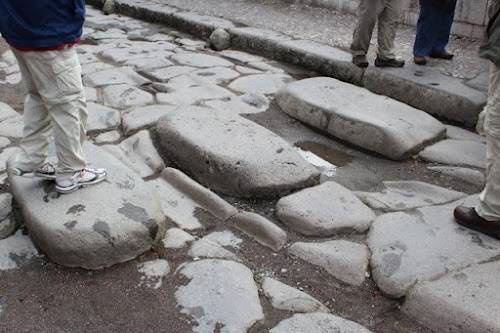In case you're wondering, I'm skipping day 9. That was a travel day from Greece to Italy. Nothing to speak of really. Just a short plain ride and a long bus ride from Rome to Naples.
On Wednesday, we started out in Pompeii. This city was buried in August of 79 AD by ash from Mount Vesuvius. By the end of 3 days, the ash was about 5 meters deep and had buried the entire city. Most the bodies found were from people that died the second day when they returned to search for survivors. On thesecond day a poisonous gas covered the city and people died instantly. Most people were found near the gates trying to get out of the city. Because the city was buried so quickly, it is very well preserved.
This is the sea gate. It's rather steep, so it wasn't used all that often for goods.
Below the sea gate, we can see places for boats to dock. The shore was right here in the first century.
This region didn't have a close supply of marble, so they made columns of brick and covered them in plaster to make them appear like marble.
Some marble was available (for a price) and this was a highly decorated door frame. Can you find the bumble bee?
Frescos are very well preserved. Actually they are in more danger now that they are uncovered due to the humidity and the tourists.
A view into the public square. The rocks mark the point at which chariots are not allowed beyond. I think we still have these in our modern world.
The public bath, separate for men and women. This was the men's side.
A nice mosaic. Similar ones show up at the entrance of many wealthy households.
A mill for making flour.
And the oven that was in the same bakery.
Stepping stones to get across the street. Plumbing was only available in the area of the public bath.
Decorated fountains were scattered around the city and served both as fountains and street signs.
Graffiti on the wall of one of the best restaurants in town. The graffiti was advertising food available and bragging about the quality of the restaurant.
A "fast food" place. Pompeii had numerous shops like this. The holes would have terra cotta pots with wine in them served both hot and cold.
A number of people were found near this wall. The bodies are visible because when a cavity was found by archeologists they would fill it with plaster. All flesh and most bones are gone. These people were killed the second day when the poisonous gas flowed down from the volcano.
The amphitheater.
We walked by a very nice church in Pompeii on our way to lunch.
Then we headed for Herculenium. Herculenium was buried by a mud flow caused by the volcanic eruption. Since it was buried by mud instead of the ash falling, some things are preserved here that were not in Pompeii. Original wood is visible in some places, but no bodies or body cavities were found.
Herculenium was also much smaller than Pompeii. It had better plumbing and since it was close to the sea with a nice sea breeze, windows were present in many of the houses.
Here's a drain in the street for storm water and whatever else was deposited in the street.
Some original wood, 2000 years old.
A press used to press wool. They would wash the wool fabric in very hot water and then press it to make it water proof.
One of the restaurants in Herculenium. There were far fewer here than in Pompeii, indicating that perhaps people ate at home more often.
A fountain to mark an intersection near the sea gate.
A fancy fountain. Not sure where it would have been. It is in a tunnel now because it is under a modern building. They dig tunnels to excavate portions of the city that are under modern buildings.
A shop for wine.
A small garden in the back of a home. The stage would have been used for plays put on by the slaves.
Many houses had these water collection basins in the middle of the atrium. They would drain to a cistern and the large opening visible in front would be used to bring up water.
A portion of the city still buried.
A vineyard replanted with vines present 2000 years ago. They use the roots to identify the plants that were present.

































No comments:
Post a Comment